Caroline Juang: Blending Art, Science, and Outreach
In addition to studying climate-related hazards, Juang is a talented artist who helps make STEM fields more accessible for underrepresented minorities. Somehow, she also finds time to sleep.
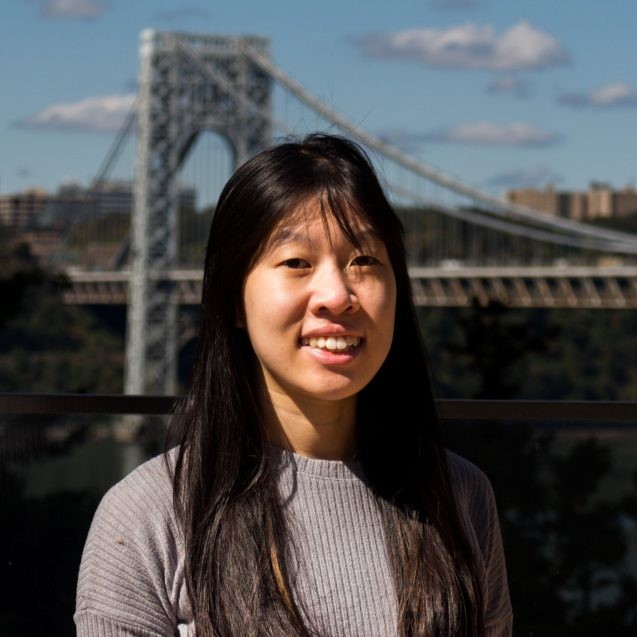
In a 2002 TED talk, former astronaut Mae Jemison urged the public to make it our mission to integrate science with art in our thinking, education, and outreach. She proposed that in framing art and science as a dichotomy, and asking people to choose whether to be “logical” or “creative” (but not both), we lose talent on both sides.
Fortunately for the fields of science and art, Caroline Juang’s parents and mentors did not ask her to make this choice, supporting her as she pursued her passion for the arts while encouraging her interest in science, and in particular — like Mae Jemison — space and working with NASA. Today she is an artist, a STEM promoter, and a PhD student at Columbia University who uses satellite data and other techniques to study climate hazards.
A scientist is born
Caroline’s parents, both scientists, shared their enthusiasm for NASA’s work with her when she was a child by introducing her to the INSPIRE Online Learning Community. Later, just after finishing high school, Caroline interned at the NASA Goddard Space Flight Center in Greenbelt, Maryland under the guidance of Dalia Kirschbaum. There she worked on developing models to predict landslide likelihood using rainfall data from large databases. During this internship, Caroline learned that in addition to the satellites that NASA uses to monitor space, NASA also uses satellites to monitor Earth systems. This realization and experience was the jumping-off point for Caroline’s concentration on earth science that she maintains to this day.
When Caroline began her undergraduate studies at Harvard University, remembering how much she loved her high school internship project at NASA gave her confidence in choosing to major in Earth and Planetary Sciences. To gain more experience doing earth science research, she spent her summers working internships, delving into research on the Mars polar ice caps, food sustainability, and space policy. As an upperclassman, she decided to focus her senior thesis research on understanding carbon exchange in the Harvard Forest in central Massachusetts. She received an honors recommendation for this work.
After graduating with her Bachelor of Arts in Earth and Planetary Sciences and a minor in Environmental Sciences and Public Policy, Caroline decided to return to work for Dalia Kirschbaum at NASA Goddard as a project coordinator. This time, instead of just building out landslide databases, Caroline developed a community-based science project (“the Cooperative Open Online Landslide Repository”) to invite people around the world to submit landslide data. She analyzed data from the first year of results and was able to show that data from community scientists was viable and could be used for future modeling and scientific research.
While cataloging and building these databases, Caroline began learning about the 2017 Thomas Fire that triggered mudslides across much of southern California, leading to fatalities and devastating infrastructure damage. She found herself astounded by the severity of the impact, as well as by the interconnectedness of the hazards. Up until this point, Caroline’s research was focused on landslides, but now, here she was wanting to learn as much as she could about fire.
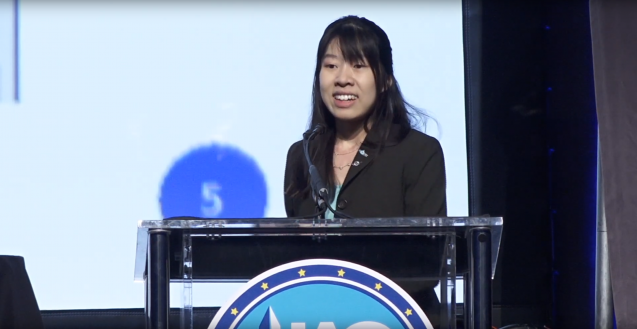
Soon after this new interest sparked, Caroline was reading abstracts for a conference and discovered the work of Park Williams, then a hydroclimatologist at Columbia Climate School’s Lamont-Doherty Earth Observatory (now based at UCLA) studying how climate change interacts with droughts and wildfires in the western United States. Inspired by her colleagues at NASA, Caroline had already begun to consider going to graduate school — she wanted to learn more about modeling within natural hazards research, and build her expertise so that she could eventually lead projects. When she found Park Williams, and later learned that they have common interests in both research and outreach as well as a shared enthusiasm for collaboration, she decided it was time to begin her graduate career.
As a PhD Student in Columbia University’s Department of Earth and Environmental Sciences, working in Park Williams’ research group (“The HyFiVeS Research Group” which stands for “Hydroclimate, Fire, Vegetation, and Society”), Caroline has been able to pursue her diverse set of interests. She is focused on using satellites and big datasets to model wildfire in the western United States, and was awarded a Future Investigators in NASA Earth and Space Science and Technology grant to fund this study. In her first chapter, published in Geophysical Research Letters, she discovered that the total forest-fire area burned annually grows exponentially with aridity in the western United States because of rapid increases in the sizes of the largest forest fires. Individual fires spread across the landscape at compounding growth rates, so the largest fires have the largest potential for growth. Thus, each incremental increase in dryness leads to a much larger increase in burn area each year. In other words, Caroline explains, “the largest 10% of fires each year were responsible for approximately 67% of the observed increase in annual forest area burned between 1984 and 2019.”
With this research and much more to come from her PhD, Caroline hopes to contribute to our understanding of natural variability in wildfire as well as how fires are influenced by climate change. Her ultimate goal is to improve our ability to predict climate-fire interactions to inform disaster response efforts, and her next chapter explores the uncertainty in predictive models of fire activity.
Presented my proposed dissertation research today at @LamontEarth! Eternally grateful to my advisor, committee, mentors, & friends for the support to achieve the M.Phil. I’m ready to continue modeling the drivers of variability in wildfire in the western US 🔥 @columbiaclimate pic.twitter.com/QQFNe02Y3U
— Caroline Juang (@caro_in_space) August 23, 2022
This work is clearly a massive undertaking. Caroline even constructed and maintains a database that combines satellite data and fire data from government agencies, and she performs all of the time-consuming data cleaning that goes along with database management.
Caroline says that, although taking the shuttle bus to the Lamont campus is definitely not her favorite daily activity, working there “has been inspirational and highly motivating. What really makes this program is the people that I’ve connected with and shared ideas with. It’s a very collaborative environment with a lot of great climate work going on. It’s just really cool having the Lamont-Doherty Earth Observatory community be a part of my PhD experience. There’s so much collaboration between students, post docs and professors. I’m also very grateful for my advisory committee. They give such great feedback and have stayed connected with me even throughout the pandemic.”
Making time for art
With so much work already on her plate for her research, one would expect that she wouldn’t have time for much else. To that, Caroline says, “you find time to do things that you want to do.”
Caroline always wanted to be an artist, since as far back into childhood as she can remember. Her parents, as scientists, motivated her to explore STEM in order to be able to share their love of science with their daughter. But they also bought Caroline her first tablet for digital drawings and made sure that she always knew that they valued her art. While Caroline had support, when it came to art, she didn’t have guidance, but she had the motivation to teach herself and seek out learning opportunities where she could find them. In middle school, with a packed academic schedule, Caroline didn’t have an open time slot to fit in art classes, so she asked the 8th grade art teacher if she could just sit in on classes to learn about drawing with charcoal while eating her lunch. Finally, in 11th and 12th grade, Caroline was able to take some studio art classes at her public high school to learn new mediums. Her love for art continued growing and soon she began to participate in art competitions, and even design logos for various organizations.
Now as a PhD student, in addition to her science, Caroline is an artist. “I used to call myself a scientist and an art-hobbyist… but then I realized, no, I am an artist. The work-day as a graduate student is doing earth science research, but the amount of passion that I have for art and the time that I spend on art is substantial. Technically, I am an artist on the side, but it’s just as much a part of my identity as science. Also, I get paid for my art sometimes, so I guess I can’t call myself a hobbyist.” Art and science play equally important roles in her life and her career plans.
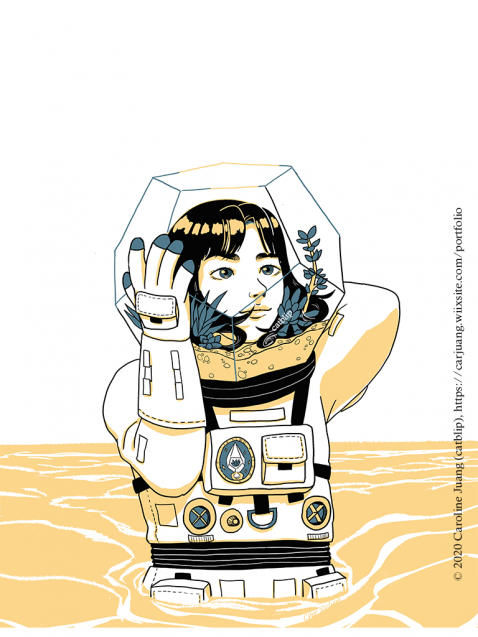
Recently Caroline has begun to bring these passions together by connecting her artwork to her identity as a scientist and as a Taiwanese-American woman in STEM. Although she still loves drawing cats and horror comics, lately she’s been centering Asian female astronauts in her artwork. Caroline hopes that by doing so, she can create sources of inspiration for others that she didn’t see as she was trying to imagine herself as a scientist while growing up. One recent piece that Caroline is particularly proud of, titled, “You are Thriving,” features an Asian American astronaut who is waist-deep in water, seemingly with nowhere to go. However, despite the challenges and uncertainty that she is faced with, she is grounded in her own identity — symbolized by a terrarium in the helmet of her spacesuit. Remembering who she is keeps her focused and allows her to continue to move forward and explore.
Caroline has brought her love of art and science together through her logo design work as well, by creating logos for scientific organizations, like this cute and thoughtful logo that she designed for the Brook Owen Fellowship program, and this one for the Asian Americans and Pacific Islanders in Geosciences group. She also has a comic in production now that tells the story of Swati Mohan, who navigates NASA’s Perseverance rover on Mars, which Caroline is working on for Space Generation’s Diversity & Gender Equality Project group as one of their illustrators. This work will be released in the second edition of the Our Giant Leap magazine in early fall (stay tuned!).
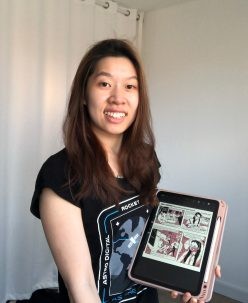
Whether it’s art in the form of traditional mediums like working in ink and acrylic (which Caroline also enjoys), or digital art, creating these images is time-consuming. She is also the sole writer of her comics, and the story development and writing process involves a great deal of research so that she can properly lay the groundwork, provide necessary historical information, and set up the context that she needs to tell a story. Because of this added work, including storyboarding, creating thumbnails, and calibrating the timing for comics, Caroline has had to make some hard decisions regarding limiting the projects that she can take on, especially to make more room for another crucial part of her identity — outreach and community empowerment.
Making space and science more accessible
For Caroline, community empowerment and outreach means a lot of things beyond inspiring people through her art. For example, she regularly visits elementary and high school students to talk about her research, and participated in the New York Academy of Sciences Chat with a Scientist. She also serves on the executive board for the Brooke Owens Fellowship program, a non-profit internship and mentorship program for women and other gender-minorities interested in aerospace careers. She has an understanding of the program from multiple perspectives because she was a fellow in the program herself, which guides her now as she manages the program. Caroline is hands-on in bringing in each class of fellows, matching them to mentors and competitive internships across the industry (including places like SpaceX and Blue Origin), and hosting a four-day summit with a grand challenge project to solve a problem in the industry. She remembers that when she was a fellow, her project was a thought-challenge in using satellite capabilities to alleviate drought while working with the affected community. Caroline has been excited to see some of the more recent projects go on to be proposed as startups.
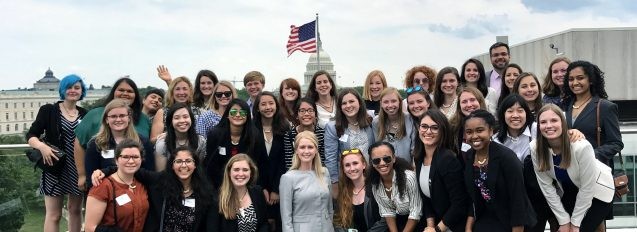
Caroline first learned about the Brooke Owens Fellowship Program through a Facebook group that she was a member of. She remembers thinking, “How can people who are not already well-connected find out about these great opportunities?”
Driven by the realization of this issue of inaccessibility, Caroline decided to create a platform of resources to direct people towards opportunities that typically aren’t found on job-boards (e.g., scholarships, grants, fellowships, and internships). She approached her old friend from high school, Chris Fu, who is a software developer, to invite him to co-found this platform with her, build out the website, and take charge of managing user experience and design. He was excited about the idea, so together they cofounded Space Interns, a database listing hundreds of opportunities for high schoolers, undergraduates, graduate students and early career professionals. The site also includes guides, created by multiple organizations and aggregated by Space Interns, on how to get into the space industry.
Cultivating these lists of opportunities involves hours upon hours of scouring Twitter and other sources; many opportunities were simply shared by word-of-mouth, others were compiled in Google spreadsheets. It was a big effort to bring all of these opportunities together and make them searchable and filterable (e.g., for characteristics that make someone eligible for different internships or fellowships, like being a part of a specific under-represented group). Luckily, they now have a small team managing the website and keeping it up-to-date.
“It’s a grassroots team effort to make space and STEM in general more accessible to everybody,” Caroline explained. “We are also trying to emphasize that space isn’t just engineers, it’s scientists, artists, people who work in finance, and more, all playing different, important roles in making the space industry a whole.”
Obviously this is a lot for a graduate student to have on their plate, but Caroline swears that she gets plenty of sleep. She feels that working on her art is a great mental health outlet — especially when she can use art to uplift her community. Caroline also gives credit to her advisor, Park Williams, who she says “values the outreach and science communication. Having that support has been really helpful in allowing me to balance it all.”
Alexis Earl is a PhD candidate in Ecology and Evolutionary Biology at Columbia University.
